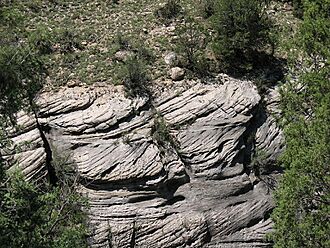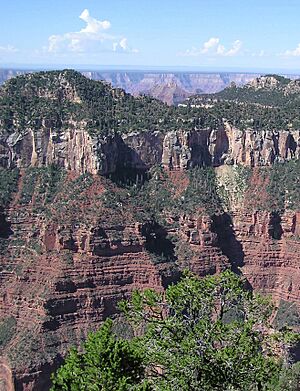Coconino Sandstone facts for kids
Quick facts for kids Coconino SandstoneStratigraphic range: Kungurian |
|
|---|---|

Cliff of cross-bedded Cocconino Sandstone at the Walnut Canyon National Monument, Arizona.
|
|
| Type | Geological formation |
| Sub-units | Harding Point Member and Cave Spring Member |
| Underlies | Toroweap Formation and Kaibab Limestone. Its upper part also interfingers and merges laterally with the Toroweap Formation. |
| Overlies | Hermit and Schnebly Hill formations. It also interfingers laterally with the Schnebly Hill Formation. |
| Area | Colorado and Coconino plateaus. |
| Thickness | 65 feet (20 m) to 300 feet (91 m) in Grand Canyon region. |
| Lithology | |
| Primary | cross-bedded sandstone |
| Location | |
| Region | Arizona–(northern) and Utah–(southern) |
| Country | United States – (Southwestern United States) |
| Type section | |
| Named for | It is named for the Coconino Plateau, northern Arizona |
| Named by | Darton (1910) |
The Coconino Sandstone is a special type of rock found in places like the Grand Canyon in Arizona. It's a light-colored sandstone that formed from ancient sand dunes, blown by the wind a very long time ago. This rock forms tall, steep cliffs in the Grand Canyon and other areas of the Colorado Plateau.
Scientists love the Coconino Sandstone because it has amazing fossils. These fossils are not bones or shells. Instead, they are trackways, or footprints, left by ancient land animals. It also shows cool patterns called cross-beds, which tell us how the sand dunes moved.
The Coconino Sandstone was named in 1910 by a scientist named Darton. He named it after the Coconino Plateau in northern Arizona, where this rock is very common.
Contents
What Does Coconino Sandstone Look Like?

The Coconino Sandstone is mostly a light tan or white color. It's made of tiny, round grains of quartz sand that are stuck together. Most of the time, it doesn't have much iron in it, which is why it's so pale. But sometimes, you can find it stained brown or even bright red in places like Marble Canyon or near Flagstaff, Arizona.
One of the most interesting things about this rock is its patterns. You can see huge, slanted layers called cross-beds. These layers show how the sand was piled up by the wind in ancient dunes. They can be very long, sometimes up to 80 ft (24 m)! These layers usually tilt in one main direction, telling us which way the wind blew millions of years ago.
You might also find other cool features in the Coconino Sandstone:
- Ripple Marks: These are small, wavy patterns, like those you see on sand today after the wind blows over it.
- Raindrop Impressions: Believe it or not, you can sometimes see tiny, crater-like pits left by ancient raindrops! These show that the sand was exposed to the air and rain.
- Slump Marks: These look like small landslides. They formed when parts of the sand dunes became too steep and collapsed.
The Coconino Sandstone's thickness changes a lot. In the Grand Canyon area, it can be as thin as 65 feet (20 m) in the west. But in the middle of the canyon, it gets much thicker, over 600 feet (180 m)! Then it thins out again to about 57 feet (17 m) in the east.
Ancient Footprints and Fossils
The Coconino Sandstone is famous for its trace fossils. These are not the actual bodies of plants or animals. Instead, they are signs of life, like footprints or burrows. Scientists haven't found any plant fossils or animal bones in this rock. But the trace fossils tell us a lot about the ancient desert environment.
Many of the trace fossils are from invertebrates. These are animals without backbones, like worms, millipedes, spiders, and scorpions. The most common invertebrate track is called Paleohelcura, which might have been made by a scorpion. These tracks are often found on the slanted layers of the ancient sand dunes. Scientists think these animals walked on dry sand that later got damp, perhaps from dew, and then was covered by more sand. This helped preserve the tracks.
The Coconino Sandstone also has many well-preserved vertebrate tracks. These are footprints from animals with backbones, like ancient reptiles and other creatures. Scientists first reported these tracks in 1918. Since then, many studies have looked at how these animals moved and lived in the ancient desert.
One interesting fossil shows two sets of tracks crossing each other. One set is from an insect, and the other is from a four-legged animal (a tetrapod). Some scientists think this might show a moment when the four-legged animal was hunting the insect!
These fossil tracks are very important. They help scientists understand what kinds of animals lived in this desert millions of years ago. They also help us learn how these animals walked on sand dunes.
How the Coconino Sandstone Formed
The Coconino Sandstone formed about 275 million years ago. It was created when fine, well-sorted sand was blown by the wind and piled up into huge sand dunes. This process is called eolian deposition.
All the features we see in the rock, like the large cross-beds, ripple marks, raindrop impressions, and animal tracks, are strong proof that this rock formed in an ancient desert environment. The type of sand and how it's put together also fit with it being formed by wind.
Meteor Crater Connection
The Coconino Sandstone is also famous for another reason. It's the rock that a meteorite crashed into at Meteor Crater (also known as Barringer Crater) in Arizona. When the meteorite hit, the extreme heat and pressure changed some of the sand in the Coconino Sandstone. It created special types of glass and minerals that only form under very high pressure, like Lechatelierite, coesite, and stishovite.
See also
- Geology of the Grand Canyon
Images for kids
-
Cliff of cross-bedded Cocconino Sandstone at the Walnut Canyon National Monument, Arizona.
-
Sequence in section of North Rim showing rockfall:
White Coconino on eroded slope of Hermit Shale upon resistant & sloping Supai Group – "redbeds".







